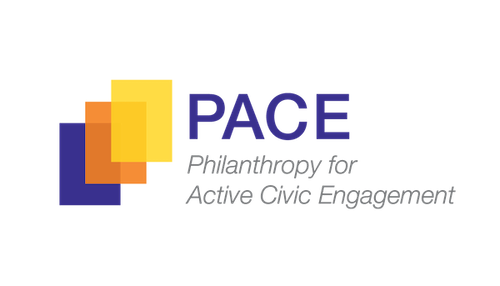Sally T. Prouty, Fellow, PACE-Philanthropy for Active Civic Engagement
June 2013
The goal of my nearly 30 year career has been to improve the life chances of youth and young adults by highlighting their potential and the challenges they face and by advancing strategies to address the challenges. My hope is to stimulate policy discussion and provide insight that is useful to others on a similar journey.
According to the Campaign for Youth, one third of American students and nearly half of all students of color do not graduate from high school. Of those who graduate from high school, roughly one-third are unprepared for college-level academics. That number increases to 43% for those enrolled in community college. Many young people who have had difficult life experiences – those 14-17 year old adolescents who do not complete high school, or are deeply involved in the juvenile justice system, or are young, unmarried mothers, or in a foster placement – absent opportunity and support will not successfully move into productive adulthood.
My experience in the fields of service and youth development confirms that disconnected youth, young people who fall into these categories, want to be productively engaged. They have amazing potential, every bit as much as their more accomplished peers, and want to be contributing members of society. They lack the opportunity and support necessary to achieve their potential. Unfortunately, community leaders and citizens in general seem to lack awareness of the value of engaging these young people as assets to their communities.
The Obama Administration and several national organizations have worked in the past few years to put disconnected and disadvantaged youth on the national radar screen and it is imperative that we take advantage of the current heightened awareness to change the way we think about these ‘opportunity youth’ and move from thought to action.
Research reported in the White House report Opportunity Road: The Promise and Challenge of America’s Forgotten Youth, estimates the social and economic cost associated with long term youth disconnection to be $252 billion per year and confirms the desire of disconnected youth, referred to as Opportunity Youth, to be productively engaged.
The challenge of reengaging the six to seven million young people who are out of the mainstream and providing opportunity and support to the estimated 7,000 who drop out of high school daily is immense. It is a far greater challenge than we can address working with 50, 100 or even a few thousand young people at a time, although these efforts should certainly continue.
To achieve impact at a level required to meet this challenge requires greater understanding of the causative factors resulting in disconnection and advancing strategies designed to address these factors. My experience suggests that negative community influences and increased engagement in risk behaviors, including the use and abuse of alcohol and other drugs, are among the most significant causative factors. Acknowledging that many factors play a role, it is clear that contact with positive, caring adults and a supportive community are essential if our young people are to overcome the negative influences and be prepared for productive adulthood.
Building safe, healthy, drug-free communities is what Community Anti-Drug Coalitions of America (CADCA) a 20-year old independent nonprofit organization representing 5,000 community coalitions is all about. Research shows that CADCA’s data-driven comprehensive coalition approach reduces substance abuse rates in communities. The coalition approach is the centerpiece of the prevention portion of the White House Office of National Drug Control Policy’s National Drug Control Strategy. Even when effective approaches are identified and supported more work needs to be done. General Dean, CADCA Chairman and CEO said, “Too many young people are still destroying their lives and their families’ lives due to substance abuse.” Student substance abuse is a risk factor for academic problems such as lower grades, absenteeism and high dropout rates. Alcohol, tobacco and illegal drug use can interfere with a student’s ability to think, making learning and concentration more difficult and impeding academic performance. The more a student uses alcohol, tobacco and other drugs, the lower his grade point average is likely to be and the more likely he is to drop out of school. Compared to their non-using peers, high school students who use alcohol or other drugs are up to five times more likely to drop out of school. Those who begin using marijuana before age 13 usually do not go to college, while those who have abstained from marijuana use, on average, complete almost three years of college.
No matter how good our schools and alternative programs are, unless we acknowledge and effectively address the challenges associated with the use and abuse of alcohol and other drugs, large numbers of young people have virtually no chance of being productively engaged. In my seven year stint as director of a state wide conservation corps operating two residential and six non-residential sites, I had the opportunity to know hundreds of young men and women who were working hard to get their lives back on track. Drug/alcohol testing, access to counseling, treatment and 12 step programs contributed significantly to their success.
In 2010 I was introduced to Community Renewal International – the largest example of civic engagement that I have seen – a largely volunteer effort designed to capitalize on the dedication of community residents to change lives while building a renewed, caring community. In Shreveport, Louisiana this approach has yielded a We Care team of over 50,000 people, hundreds of volunteers and a changed community. After a visit to Shreveport, Ed Morrison, from Purdue’s Center for Regional Development, noted that the prevailing approach to poverty is to see it as a set of largely unconnected problems that somehow can be fixed. At the federal level, we have a proliferation of strategies to deal with weak schools, poor health, dilapidated housing and absence of jobs. He says that none of these work very well because they are addressing symptoms and suggests that it is necessary to build community first before moving to higher levels of prosperity. He suggests that Community Renewal International is a model of how communities can be renewed. What has happened in Shreveport and been adapted for use in other communities deserves serious attention and study. The principles and practices could be adapted for use in any community.
Service and civic engagement have become increasingly important subjects in discussion of strategies to address complex national challenges including reengaging youth. In concert with community based partners, service provides access to pathways leading to success in postsecondary education and careers while also empowering youth as leaders and problem solvers in their communities.
Civic Pathways Out Of Poverty and Into Opportunity, published by PACE, Philanthropy for Active Civic Engagement, examines this possibility and challenges readers to consider the possibility that service and civic engagement infrastructure can be utilized, in concert with other organizations and institutions, to improve educational and workforce development opportunities for low-income youth. It also challenges service and civic engagement leaders and funders including the Corporation for National and Community Service and other federal agencies to support significant increases in the number of vulnerable youth and young adults engaged in service – including those who have dropped out of high school, those aging out of foster care, and court involved or formerly incarcerated. The report suggests that there is tremendous potential to build upon lessons learned from current initiatives. With a focus on transitioning young people out of poverty, it proposes reframing the discussion regarding the value of service and civic engagement to society and suggests that the potential of service to expand life-changing opportunities for the poorest young people has not been sufficiently studied or discussed.
Advancing national service based on individual programs will not result in reaching the millions of young people who are waiting to be engaged. Rather, advancing service, service learning and civic engagement principles and practices in the context of the whole community could ultimately bring about the changes that we seek. Relevant local, state and federal agencies and organizations working in concert with youth centered, community based coalitions – empowering communities to join forces in support of children, youth, and young adults – holds great potential.
Recommendations:
- Engage community focused experts representing national and community service, education, positive youth development, mental health, substance abuse prevention and treatment and community renewal to outline a plan for empowering local residents to assume responsibility for their own community while simultaneously adopting a locally designed plan for supporting the positive development of children, youth and young adults.
- Support 4-6 communities in piloting this newly outlined approach over a 3-5 year period.
- Evaluate implementation and effectiveness. Revise the plan based on research findings.
- If merited, increase the number of communities engaged in the pilot and evaluation process.
Conclusion
Service is not the sole answer to the challenges facing disconnected youth but it represents a significant piece of the puzzle that provides answers. If we enhance community based work already underway utilizing service, service learning and civic engagement principles and practices to empower communities to change from within, focus on health and wellness to stem the flow of young people coming to school unprepared, enhance school reform and continually improve solutions to reengage those who are out of school, our chances of making a large scale difference will be significantly increased.
Looking back over my career has been both rewarding and difficult. Remembering the faces of young people whose lives have been forever changed has been wonderful. Being reminded of how difficult it is to build effective ‘civic pathways’ and how quickly, by the stroke of a pen, they can be eliminated is painful.
As a nurse, I came to the world of service and youth development with a health and wellness focus. After 30 years I am convinced that absent a focus on the whole community and individual health and wellness much of the effort is unlikely to have long term positive results. I remain hopeful that the heart of the struggle, gaining committed champions who recognize the value of all young people, will become less a struggle and more a national realization. I am grateful to PACE for challenging me to document my thoughts and share my perspectives.
______________
After nearly a decade as President and CEO of The Corps Network (TCN), Sally Prouty served as a PACE Fellow in 2012 and 2013 providing thought leadership and guidance on their ‘Civic Pathways Out of Poverty’ project. Prior to her time at TCN, Prouty served seven years as Director of the Ohio Civilian Conservation Corps and four years as Deputy Director of Ohio’s Department of Natural Resources. Prouty has held volunteer positions at the local, state, national, and international levels, including service on a city board of education, on the founding board of a charter school and on multiple other boards and commissions including as founding co-chair of both Voices for National Service and the National Campaign for Youth. She currently serves as a member of the national advisory board of Community Renewal International. A Registered Nurse, she also holds a degree in organizational communication from Capital University.


